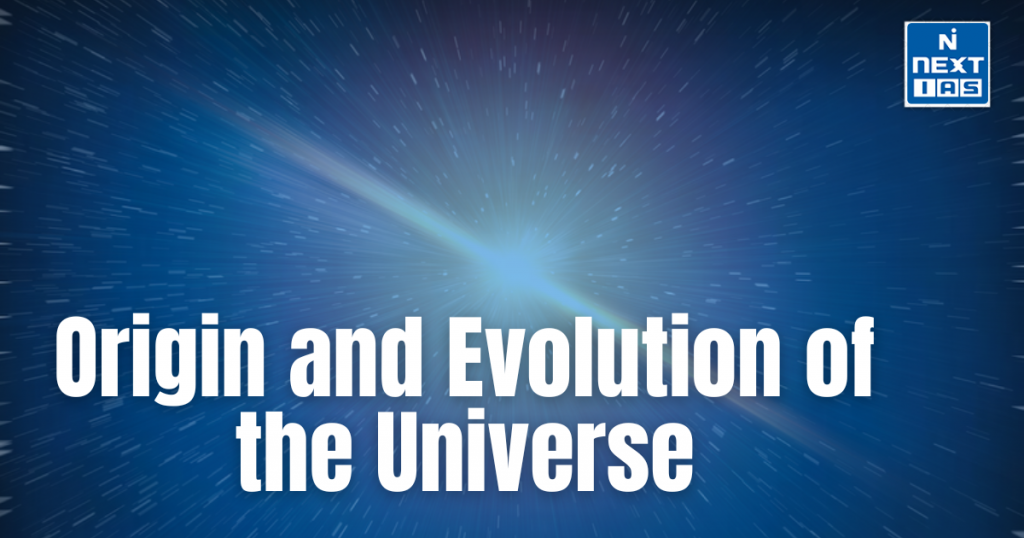
The formation and evolution of the universe examine everything concerning the Big Bang and the development of the present. An attempt to understand how matter, galaxies, stars, and planets come into being and spread themselves throughout their realms is to understand cosmic phenomena and the forces that have shaped the very existence of the infinite universe.
About The Origin and Evolution of the Universe
- Big Bang Theory is essentially a theory explaining the origin and evolution of the universe; it suggests that the universe started nearly some 13.8 billion years ago from a singularity of infinite density.
- The universe was initially a hot, dense plasma. During an episode of rapid expansion known as cosmic inflation, it cooled and allowed particles to come into existence. These particles then gradually combined to form atoms, with stars and galaxies emerging from them.
- Clusters of galaxies formed and gravitational forces began to organize their structure. Within stars, nuclear fusion proceeded to form heavier elements that were dispersed into space during supernova explosions, thus enriching the universe with the building blocks for planets and life.
- Then, the universe kept expanding, which was first found out in the 1920s by Edwin Hubble.
- Dark energy is quite an unknown force concocting to hasten the expansion. Study of the origin and evolution of the universe goes on, with cosmological breakthroughs shedding ever deeper insights on the story of the far and wide.
Composition of Universe
The universe stands for all matter, energy, and cosmic phenomena. Let’s further explore the major components:
Ordinary (or Baryonic) Matter
- Stars and Planets: This is matter we see in the present universe-whether stars, planets, moons, or asteroids-matter made of atoms, chiefly hydrogen and helium.
- Nebulae: Clouds of gas and dust, sometimes where stars are born.
- Galaxies: Enormous abodes of stars, gas, and dust with gravity binding the ensemble together.
- This type of matter constitutes a mere 5% of the universe.
Dark Matter
- Invisible and Mysterious: A type of matter cannot give, absorb, or reflect light; thus, it cannot be observed via electromagnetic radiation.
- Gravitational Influence: It affects galaxies and clusters of galaxies in terms of gravitation, hence influencing their motion.
- This accounts for 27% of the universe’s total mass-energy.
Dark Energy
- Accelerating Expansion: It is an unknown form of energy responsible for accelerating the expansion of the universe.
- It constitutes 68% of the total content of the universe.
Cosmic Microwave Background Radiation (CMB)
- A faint glow left over from the Big Bang, providing a snapshot of the early universe and evidence of its initial hot, dense state.
Cosmic Structures
- Clusters and Superclusters: Galaxies are organized into clusters, and clusters form larger structures known as superclusters.
- Void Spaces: Large regions of the universe with very few galaxies, known as cosmic voids.
Thus, the universe is primarily composed of dark energy, dark matter, and a small fraction of ordinary matter, with ongoing research aimed at better understanding these components.
Significance of Study of Origin and Evolution of Universe
The origin and evolution of the universe constitute the backbone of modern science, giving deep insight into the occurrence and existence, natural laws, and even the imminent death of the cosmos. Its importance can be looked at from various angles:
Understanding Fundamental Laws of Nature
- The study of universe origin from the Big Bang theory potentially reveals fundamental physical laws of nature, such as gravity, quantum mechanics, or thermodynamics.
- It may integrate our understanding of how matter, energy, space, and time interact on cosmic and microscopic scales.
Cosmic Perspective on Our Existence
- Constructing a history of the universe fades humanity into its rightful cosmic shadow.
- It unites the origins of galaxies, stars, and planets with the very processes that have spawned life on Earth; hence connecting the natural world-goes-a-long-way.
Technological Enhancements
- Studying cosmology results in the developments in technology: better telescopes, satellite technology, computational models, and so forth.
- These instruments can have very wide applications, spilling into other industries such as health, communication, and monitoring of the environment.
Origins of Matter and Life
- Understanding stellar evolution and nucleosynthesis explains how elements needed for life, especially carbon, and oxygen, were formed.
- It also enlightens about life-supporting factors to better direct the search for extraterrestrial life and habitable planets.
Philosophical and Cultural Impact
- Explorations into the origins of the universe invite reflections on bigger questions regarding creation, existence, and destiny.
- This inspires human culture, unleashing the streams of art, literature, and heightened consciousness for curiosity and wonder.
Predicting the Future of the Universe
- The study of cosmic evolution sheds light on the eventual fate of the universe, like its continued expansion or inevitable contraction and heat death.
- Such happenings birthed theoretical speculations on the very long-term futures of matter and energy.
Interdisciplinary Integration
- Cosmology is the union between physics, mathematics, astronomy, chemistry, and philosophy, forming a comprehensive understanding of the universe.
Way Forward
- There are several scientific ways to define the origin and evolution of the universe. Theoretical physicists advocate that the universe began around 13.8 billion years ago with the Big Bang event from an initial singularity.
- Such a theory is supported by observation of cosmic microwave background radiation and the expanding galaxies. Evolution sees nucleosynthesis, galaxy formation, star formation, and star life cycles evolve.
- Its structure and fate are affected by dark matter and dark energy. New advances require state-of-the-art observation, computational modeling, and cooperation among cosmology, astrophysics, and quantum physics.
Conclusion
Supposedly, beginning with the Big Bang, there followed a cosmic expansion, giving rise to the making of stars and life-the origin of the universe and the present state of affairs. Governed by the fundamental way of physics, the universe is still in the process of evolution, hence, leading both parties to the mysteries of it and to humanity’s place within it.
FAQs
What is the Big Bang Theory?
The Big Bang Theory explains the origin of the universe as a massive expansion from a singular, hot, dense point approximately 13.8 billion years ago. It marks the beginning of space, time, and matter, shaping the cosmos.
Why is it called Big Bang theory?
The term “Big Bang Theory” was coined humorously by astronomer Fred Hoyle in 1949, describing the universe’s origin as a sudden “bang” of expansion from a dense state. Despite its simplicity, the name aptly captures the concept of cosmic creation.
What is evidence of the Big Bang theory?
Key evidence for the Big Bang Theory includes: cosmic microwave background radiation (residual heat from the early universe), Hubble’s law showing galaxies moving apart, and the abundance of light elements (hydrogen and helium) matching predictions from nucleosynthesis.





